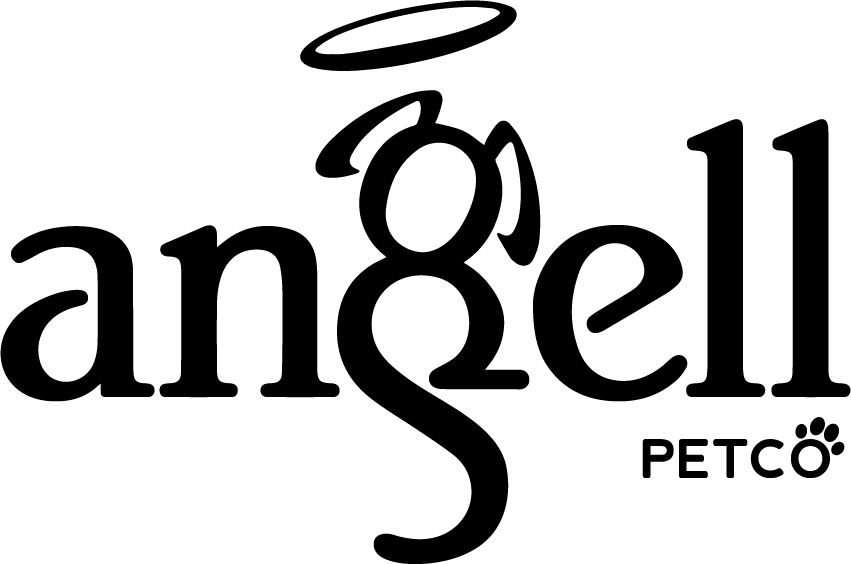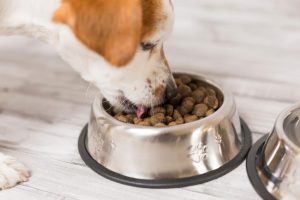Considering a grain-free diet for your dog? Get clued up before you make the switch to other fibre-rich foods.
Angell PetCo has always championed clean dog diets with foods free from grains that cause allergic reactions and upset stomachs in many dogs. Our founders, Robert and Jill Angell were amongst the first to move away from common commercial grains like wheat, maize and cereals in favour of grain-free options.
Is Grain-Free Dog Food Better Than Regular Food?
As its title suggests, grain-free dog food is without any grains — be that soy, wheat, corn, barley, rye or oats.
Regular dog food usually contains some sort of grain as the base of the food. In grain-free food, potato or sweet potato often takes its place to provide the necessary fibre and carbohydrates grain usually provides.
Grain-free food was developed for dogs with allergies.
According to BMC Veterinary, grain-related allergies — intolerances to soy, wheat and corn — account for 23% of canine allergies. This means roughly around a quarter of dogs with allergies are allergic to certain types of grain, making regular dog food unsuitable for their sensitive stomachs.
While dogs with zero allergies can comfortably eat grain and grain-free dog foods, grain-free alternatives are usually made with higher quality, natural ingredients, free from artificial additives, preservatives, flavourings and colouring that have a plethora of health benefits.
This isn’t as a result of the food being grain-free per se, but rather because the manufacturers of such brands tend to be more careful about throwaway ingredients. For example, our hypoallergenic dog foods all have a simple composition, with no more than eight or nine fresh A-grade ingredients that are gently cooked with our unique process. These types of foods are intrinsically healthy — whether your dog has allergies or not.
However, if your dog has grain allergies, they must eat food that is grain-free or free from the grain that they have an allergy to. For example, our grain options are both gluten and wheat free, as wheat is the most common cause of allergies in the grain family.
If your dog is allergic to wheat, eating regular food can cause skin and digestive problems, including vomiting, diarrhoea and even anaphylaxis.
Is a Grain-Free Diet Healthy for Dogs?
A grain-free diet is healthy for dogs but in most cases, it isn’t necessary.
The majority of dogs don’t have grain allergies and even those that do are rarely allergic to all forms of grain.
Grains aren’t necessarily a bad addition to a dog’s diet. They provide plenty of slow-release carbohydrates, which give your dog energy throughout the day. They also provide essential nutrients and fibre, helping your dog to regulate bowel movements. By acting as the base of your dog’s food, grains help to control the fat ratio of your dog’s meal.
That said, and as mentioned already, feeding your dog high-quality, grain-free food is an excellent choice, even if your dog doesn’t suffer from allergies.
The key is the quantity and quality of the ingredients that the food contains and the method in which the food has been prepared.
Here at Angell PetCo, all our complete recipes contain fresh, human-grade ingredients that are gently cooked at low temperatures, at low pressure and with minimal processing. This ensures a perfectly balanced bowl of food that is full of easy-to-digest natural benefits
And this same principle should be adopted to determine the quality of grain-free food.
Our grain-free salmon dog food is an excellent option. Healthy fresh salmon is paired with real potato to ensure your dog is ingesting enough fibre and fats to fuel his/her day. The composition of our salmon and potato dog blend is almost equal parts salmon (37%) and potato (36%) to strike the correct balance between protein and carbohydrates. The omega-3 fatty acids present in salmon also act as a great anti-inflammatory for problem stomachs and work to restore dry, itchy skin.
What’s more, if you are switching to grain-free food as a result of a potential allergy, choosing fish-based food is wise since dogs with allergies are more likely to be intolerant to meat like beef.
On the whole, grain-free diets have plenty of advantages, with the main benefit being a decreased risk of an allergic reaction.
The same logic applies to vegan diets, where people need to think about alternative protein sources. Vegan diets are notoriously healthy, yet those who don’t eat meat or dairy run the risk of becoming deficient in certain areas if they don’t substitute these items with alternatives like nuts, chickpeas and tofu.
In grain-free dog diets, dogs are initially losing their source of carbohydrates and fibre. So remember, whenever you remove something from your dog’s diet, you must replace it with another, suitable ingredient.
Are Dogs Carnivores?
There is a lot of discussion surrounding dogs. We know they are descended from wolves, which begs the question, are dogs carnivores or omnivores?
Some studies suggest that wolves may have domesticated themselves — in a move scientists call “survival of the friendliest” — during hard times. During these times, dogs experienced a shift in eating patterns, similar to those of humans. They were exposed to more grains and vegetables, which increased the bioavailability of their food, making digestion easier. This prompted a change in their digestive systems.
The question of whether dogs are omnivores or carnivores is still inconclusive. What we do know is that dogs can eat almost 100% of carbohydrates This is due to the presence of amylase in their bodies — an enzyme that breaks down the starch in the intestine. It’s clear that dogs have adapted to digest starch, the chief nutrient in grains such as wheat and rice. Furthermore, dogs also have a maltase gene — another enzyme involved in the digestion of starches. This gene is usually only found in herbivores and omnivores.
Dogs have other biological similarities to omnivores. They have molars, and they have a small intestine that occupies roughly 23% of their gastrointestinal tract. Cats, which are carnivores, have small intestines that only occupy 15%. Also, dogs are able to create their own Vitamin A from beta carotene, found in plants.
So what does all this mean in terms of grains? We should be aiming to feed our dogs a diet that is most beneficial to them. At Angell PetCo, we believe this involves eating food that contains a significant amount of high-quality protein, balanced with vegetables and other minerals. We focus on the balance and bioavailability of the food, as well as the quality of the ingredients. We will only use fresh, local, human-grade food that has been cooked gently to preserve its nutritional value.
We don’t think it’s as simple as saying that grains are bad for dogs (although, of course, grains should be avoided if dogs have an intolerance or allergy). We do, however, believe that dog food made predominantly of cheap grains isn’t the best for your dog, their skin, their joints or their fur. They need more than just grains to survive and thrive. Grain-free food is so successful and popular because grains are replaced with high-quality ingredients, providing a better all-round food. With grain-free dog food, pet owners and vets often see a noticeable difference in their pets.
The FDA and Grain-Free Dog Food
The US Food and Drug Administration (FDA) has released a report stating that grain-free dog food isn’t optimal for dogs, suggesting a link between grain-free dog food and canine dilated cardiomyopathy.
However, the FDA was specifically discussing dog food without the right balance of ingredients, and those cooked poorly, thereby reducing the bioavailability of the food. This is something we prioritise here at Angell PetCo. For most dogs, grain-free dog food is neither good nor bad. It comes down to the quality and balance of ingredients, as well as the process involved when cooking.
When Should I Make the Switch to Grain-Free Dog Food?
If your dog is experiencing symptoms of allergies — either in their skin or stomach — you need to be on the hunt for hypoallergenic dog foods. The switch to a different dog food should happen almost immediately, to quell any nasty reactions. Initially, we recommend using salmon dog food to eliminate the risk of reactions to both grain and meat.
You can later determine whether grains — or a specific form of grain — are the cause of your dog’s allergies, with your veterinarian and when your dog is more stable.
With that said, you can switch your dog to grain-free dog food for simpler reasons like wanting your dog to have healthier skin and more energy — even better breath.
Grain-free food brands or brands with more transparency about the type of grains they use tend to be all-natural, which gives your dog a greater source of nutrition and with better benefits than mass-produced pet foods. Our world-first cooking process means we can preserve more nutrients from the high-quality products we use. We cook wheat-free, gluten-free dog food in small batches, at a low-temperature to create dog food that’s optimal for all dogs. As well as being free from common allergens, our dog food is also free from additives and non-nutritional fillers.
Please note, you may wish to consult your vet before altering any area of your dog’s diet — yet there should be no reason why a cleaner recipe wouldn’t be beneficial for your dog.
If the change to grain-free dog food isn’t “essential”, you can slowly introduce the new food by replacing one of your dog’s two meals per day with the new blend. It’s always advisable to make dietary changes in this way, to give your dog’s digestive system a chance to adjust.
Optimise your dog’s diet with our range of wheat-free dog food. Get free delivery and interest-free payments on recurring bulk buys.


